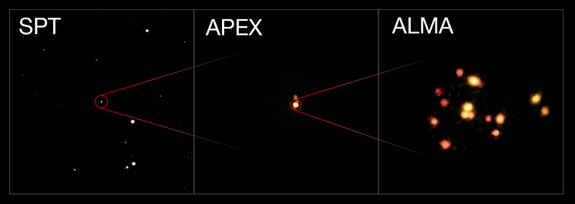Researchers spot colliding galaxies interacting in the early universe

The earliest eons of the universe were turbulent and violent.
Newly found data shows that back then — just 1.5 billion years after the Big Bang set this cosmic experiment in motion — a group of 14 galaxies in the midst of star formation merged and interacted with one another.
SEE ALSO: Astonishingly detailed map of the Milky Way will blow your mind
The galaxies found in the new data, which was collected by the European Southern Observatory's (ESO) ALMA and APEX telescopes, are known as starburst galaxies.
These types of galaxies form thousands of stars each year, as opposed to a more typical galaxy like our own, which only forms a few annually.
“The lifetime of dusty starbursts is thought to be relatively short, because they consume their gas at an extraordinary rate. At any time, in any corner of the universe, these galaxies are usually in the minority," Iván Oteo, a team member behind the discovery, said in a statement.
"So, finding numerous dusty starbursts shining at the same time like this is very puzzling, and something that we still need to understand.”
Initially, researchers thought that the galactic crash happened 3 billion years after the Big Bang, but the new observations show that the universe was only 1.5 billion years old at the time.
Scientists think that this galactic smash up was likely a precursor to the formation of galaxy clusters, the largest-known structures in the universe.

Image: ESO/ALMA (ESO/NAOJ/NRAO)/Miller
That said, researchers still aren't sure exactly how this grouping of galaxies formed in the first place.
"How this assembly of galaxies got so big so fast is a mystery. It wasn’t built up gradually over billions of years, as astronomers might expect," team member Tim Miller said in the statement.
"This discovery provides a great opportunity to study how massive galaxies came together to build enormous galaxy clusters."
Scientists will likely focus on trying to learn as much as they can about these distant galaxies to determine how they formed in the early universe.
WATCH: Scientists found a weird galaxy without dark matter


